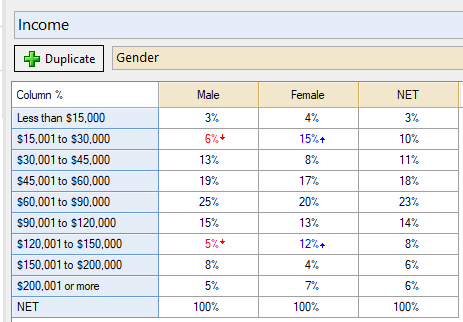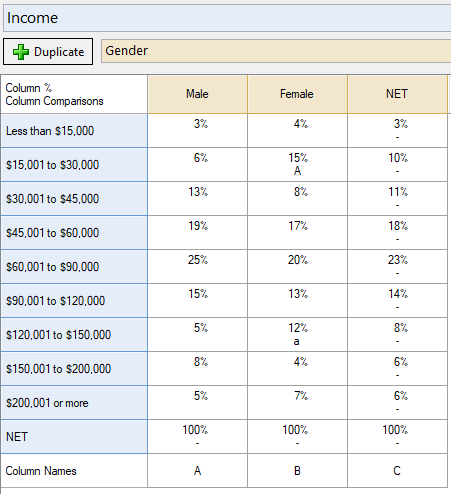Category:Tests Of Statistical Significance
| Related Online Training modules | |
|---|---|
| Automatic Tests of Statistical Significance | |
| Significance Tests on Grids | |
| Type 1 Error | |
| Population Weights | |
| Non-Proportional Sampling Weights | |
| Planned Tests of Statistical Significance | |
| Column Comparisons | |
| ANOVA with Post Hocs | |
| ANOVA Repeated Measures with Post Hocs | |
| Generally it is best to access online training from within Q by selecting Help : Online Training |
The purpose of this page is to introduce you to how significance tests are conducted in Q and provide guidance on where to find more detailed information on the various aspects of testing.
Statistical Significance Testing in Tables
There are two general ways that Q does significance testing in a table. The default method is to show results from the cell comparison method using font colors and arrows, but you can change that to the more traditional column comparison method in the Show Significance drop-down. You can also modify the underlying assumptions for these tests in the Statistical Assumptions settings or use the Automate > Browse Online Library > Significance Testing menu to apply other rules.
| Cell Comparisons | Column Comparisons |
|---|---|

|

|
To work out which test has been conducted on the cell of a table:
- Check to see if any Rules have been applied. If they have, review their documentation.
- Select the cell (or both cells if comparing columns)
- Press
 OR right click > Test Statistical Significance
OR right click > Test Statistical Significance
Frequently Asked Questions
For answers to some of the most frequently asked questions about statistical testing in Q please see below.
- How Do I Specify Columns to be Compared?
- How Do I Test Between Adjacent Time Periods?
- How Do I Change Significance Levels for Column Comparisons?
- How Do I Compare A Sub-Group Against The Total?
- How Do I Replicate SPSS Significance Tests in Q?
Links for further information
More detail on the various aspects of statistical testing in Q can be found in the following links.
- A general overview on how Q selects and performs a statistical test is here: Overview of Statistical Testing in Q
- A guide to what settings and statistical assumptions are available in Q is here: Statistical Assumptions
- Info on how Q displays significance testing
- To learn how to interpret significance testing results start here: Category: Reading Tables and Interpreting Significance Tests
- For resources on troubleshooting statistical testing in Q you can go to our Category: Troubleshooting Significance Tests page.
- Many times results differ due to:
- Overlapping data -- overlapping respondents are by default removed when doing column comparisons which may not be done in other softwares
- Multiple Comparison Correction -- helps reduce false positives found by running lots of significance tests by adjusting the critical p-value to make it harder to be found significant
- Many times results differ due to:
Other technical resources
Technical Assumptions of Tests of Statistical Significance contains a general discussion about the use and interpretation of tests of statistical significance. Further reading: Market Research Analysis Software
Pages in category "Tests Of Statistical Significance"
The following 134 pages are in this category, out of 134 total.
B
C
- Cell Comparisons
- Chi-Square Test for Compatibility of K Counts
- Chi-Square Test of a Frequency Distribution
- Cochran's Q
- Column Comparisons with Missing Data and Grid Questions
- Combined p-Values
- Common Questions About Statistical Testing in Q
- Comparing Columns Across Spans
- Complex Samples Dependent T-Test - Comparing a Sub-Group Mean to Total
- Complex Samples Dependent T-Test - Comparing a Sub-Group Proportion to Total
- Complex Samples Dependent Z-Test - Comparing a Sub-Group Mean to Total
- Complex Samples Dependent Z-Test - Comparing a Sub-Group Proportion to Total
- Complex Samples t-Test of a Mean
- Complex Samples t-Test of a Proportion
- Complex Samples Z-Test of a Mean
- Complex Samples Z-Test of a Proportion
- Confidence Interval
- Correlations - Comparing Two Numeric Variables
- Crosstabs of Proportions (One Categorical Question by Another Categorical Question)
D
F
H
- How Q Highlights Results as Being Significant
- How to Change Significance Levels for Column Comparisons
- How To Compare A Sub-Group Against The Total
- How to Conduct MANOVA Tests
- How to Conduct One-Tailed Column Comparisons
- How To Create Banner Tables Using Pick One - Multi Or Grid Questions
- How to Include the Main NET Column in Column Comparisons
- How To Override Default Statistical Testing Settings
- How to Replicate SPSS Significance Tests in Q
- How to Replicate Survey Reporter Significance Tests
- How to Specify Columns to be Compared
- How to Specify Comparisons for ANOVA-Based Tests
- How To Test Against The NET/Total/Average
- How To Test Between Adjacent Time Periods
I
- Independent Complex Samples t-Test - Comparing Two Means
- Independent Complex Samples T-Test - Comparing Two Proportions
- Independent Complex Samples Z-Test - Comparing Two Means
- Independent Complex Samples Z-Test - Comparing Two Proportions
- Independent Sample Tests - Comparing Two Means
- Independent Sample Tests - Comparing Two Proportions
- Independent Samples - Quantum Column Means Test
- Independent Samples - Quantum Column Proportions Test
- Independent Samples - Survey Reporter Column Means Test
- Independent Samples - Survey Reporter Column Proportions Test
- Independent Samples t-Test - Comparing Two Coefficients
- Independent Samples t-Test - Comparing Two Means with Equal Variances
- Independent Samples t-Test - Comparing Two Means with Unequal Variances
- Independent Samples t-Test - Comparing Two Probability %
- Independent Samples T-Test - Comparing Two Proportions
- Independent Samples T-Test - Equal Variance
- Independent Samples T-Test - Pooled Variance
- Independent Samples T-Test - Unequal Variance
- Independent Samples Z-Test - Comparing Two Means with Equal Variances
- Independent Samples Z-Test - Comparing Two Means with Unequal Variances
- Independent Samples Z-Test - Comparing Two Proportions
- Independent Samples Z-Test - Comparing Two Proportions (Pooled)
- Independent Samples Z-Test - Comparing Two Proportions (Un-Pooled)
- Information Criteria
- Interpretation of the Overall Significance Level by Q
- Interpreting Column Comparisons
M
- Mann–Whitney U
- Modifying Significance Tests
- Modifying Significance Tests Using Rules
- Multiple Comparison Correction
- Multiple Comparisons (Post Hoc Testing)
- Multiple Comparisons t-Test (Fisher LSD)
- Multiple Comparisons t-Test with Bonferroni Correction
- Multiple Comparisons t-Test with False Discovery Rate Correction
- Multivariate Tests
O
P
- P-Values
- Paired t-Test of Means
- Paired t-Test of Proportions
- Paired Z-Test of Means
- Paired Z-Test of Proportions
- Pearson's Chi-Square Test of Independence
- Pearson's Product Moment Correlation
- Pearson’s Chi-square for Canonical Correlation Analysis
- Planned ANOVA-Type Tests
- Planned Tests Of Statistical Significance
R
- Related Samples Tests - Comparing Two Means
- Related Samples Tests - Comparing Two Proportions
- Repeated Measures
- Repeated Measures ANOVA
- Repeated Measures ANOVA with Greenhouse & Geisser Epsilon Correction
- Repeated Measures ANOVA with Huynh and Feldt Epsilon Correction
- Repeated Measures ANOVA with Lower Bound Epsilon Correction
S
- Second Order Rao-Scott Test of Independence of a Contingency Table
- Setting Statistical Assumptions When Setting Up Projects
- Significance Tests Change When I Merge, Hide or Remove Categories
- Significance Tests on Trend Plots
- Simplified Independent Complex Samples T-Test - Comparing Two Means
- Simplified Independent Complex Samples T-Test - Comparing Two Proportions
- Spearman’s Correlation
- Standard Errors in an Experiment or Ranking Question Are Large or NaN
- Statistical Assumptions
- Statistical Tests for Experiment Questions
- Statistical Tests for Ranking Questions